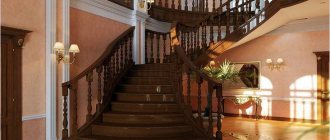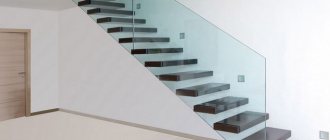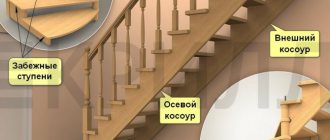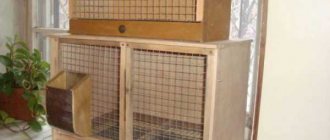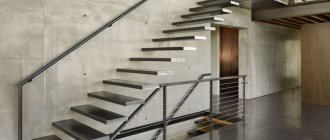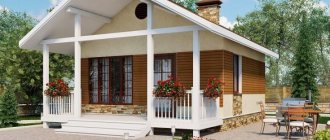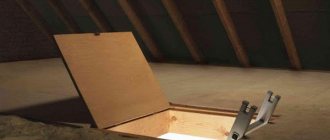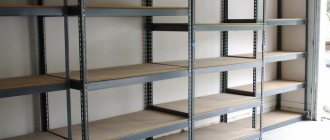A well-designed and correctly installed spiral staircase,
will be an ideal solution for arranging the transition between floors in houses,
multi-level apartments, cottages and dachas.
It has a fairly simple and original design,
and the forged spiral staircase with openwork railings combines lightness and at the same time high strength,
Suitable for installation in rooms that have limited free space.
Let us consider in detail what types of such structures there are,
their distinctive features, advantages and disadvantages of use,
and also answer two questions: how to correctly calculate the dimensions of the main structural
elements and how to make a spiral staircase with your own hands.
Distinctive features of spiral staircase structures
Like all elements present in the interior of a room, radial staircase systems can also have advantages,
and disadvantages, each of which you need to know about when choosing exactly this option for installation in a particular room.
The main feature of spiral staircases is their unusual shape, design and installation methods.
Externally, this structure looks like a petal with rounded edges,
which, after installation, can occupy an area of only 1 m2 and still provide a comfortable transition between floors,
living quarters and attic. This is where all the advantages of using spiral staircases come from:
- Compactness is a determining factor that influences the choice of stairs for small spaces. They do not clutter up the space, and if the room also has low ceilings, then the screw model will help make it visually slightly higher;
- saving space. Most often, a spiral staircase to the second floor is placed in a vertical position around a special support frame, suspended in the air; it does not have inclined straight steps, therefore it takes up little space and does not limit the space in the room;
- ease of installation. Their compact size does not require the creation of a large ceiling opening, which saves floor space on the second floor, attic or attic. In addition, it is possible to install a spiral staircase with your own hands without the use of complex tools;
- availability. The cost of spiral staircase structures is slightly lower than the price of constructing traditional staircases. This is due to the fact that their creation requires fewer consumables;
- versatility. If the spiral staircase is made of durable materials that are resistant to adverse environmental factors, then it can be used on the outside of the building as an additional one. In addition, such a model can be installed either in the center of the room, or against a wall or in a corner of the room;
- originality. A circular staircase is stylish, modern and exclusive, which allows you to add some “zest” to any interior. Which for many owners of private houses is a predetermining factor.
In addition, you can build a spiral staircase with your own hands and not overpay.
It can be made from any material without resorting to the services of professionals,
and the installation of such structures with appropriate preparation lasts no more than one day.
But for this you need to carefully study the drawings of spiral staircases,
get acquainted with the simple principle of their manufacture and understand the nuances of their design and installation.
Despite such an impressive list of advantages of spiral staircases,
they also have a number of disadvantages that must be taken into account when choosing and purchasing for a specific room. For example:
- a spiral staircase can be installed to the attic, attic, or basement in private houses, cottages or apartments, that is, in places with low human traffic;
- not convenient for small children and elderly people;
- The steps of the spiral staircase are not wide enough for the feet of an adult and during a steep climb can become a source of increased injury risk. Therefore, it is impossible to quickly go up and down such stairs, and you will have to be extremely careful all the time. This disadvantage can be compensated for by installing reliable handrails and wider steps;
- each spiral staircase has a trapezoidal shape of steps, which are different in size for the right and left legs, which interferes with normal movement and can also cause injury;
- Regardless of the type of fencing, be it metal or wooden railings, it will not allow large objects to be climbed up the spiral staircase;
- Frequently going up and down a spiral wooden, metal or concrete staircase several times a day can cause slight malaise, dizziness, and nausea. Therefore, on the second floor, attic or attic, to which such a flight will lead, it is better to equip a bedroom or an infrequently used room.
To reduce the risk of injury when using a spiral staircase,
When manufacturing it, it is necessary to strictly adhere to the developed project, comply with all the requirements of GOST and the rules for its installation.
This is the only way you will get a convenient, practical and safe product.
Manufacturing Features
The spiral staircase is characterized by its small dimensions and intricate shape, and therefore its production has a number of features. First of all, you should determine what the interior element in question is. From above, the base of the staircase resembles a kind of petal with slightly rounded corners.
Thanks to its unique parameters, the design takes up minimal space in the house (it can take up only one square meter).
If you plan to build a screw transition from wood or metal with your own hands, then you need to draw up a detailed drawing in advance. This will allow installation work to be carried out much faster and will protect against catastrophic errors, because incorrect measurements can cause the collapse of the finished product.
This type of installation work also involves studying the technology and features of the process, preparing the necessary materials and devices. Today, staircase structures are made from different types of wood (the most popular are maple, oak and beech) or using sheet metal.
Such designs save space in the house due to their small size. So, with the width of the steps being one meter, the diameter of the stairs does not exceed two and a half meters. In turn, the product has a tilt angle of forty-five degrees, which is the optimal solution for this shape.
Note! Spiral staircase structures have rather narrow steps, so residents of the house must be extremely careful when moving (this is especially true for families with small children and the elderly).
You need to be careful when descending such stairs.
Most designers agree that you should not install spiral staircases in high-traffic areas. They are much better suited for two-story apartments or small country houses.
Spiral staircase and main varieties
Spiral staircase designs come in a variety of types,
shapes and can be made from completely different materials.
Therefore, there are different types of spiral staircases, many options for their design and decoration.
But, as a rule, they all differ in the following parameters:
- depending on the material that was used to build the system, there are spiral staircases made of concrete, wood, metal, composite materials, or all of these materials in combination;
- by installation location: indoor or outdoor, for location in the center of the room, near a wall, in a corner, which determines the choice of type of fastening of steps and railings;
- intensity of use: main and auxiliary;
- shape: square spiral staircase, round and polygonal;
- type of load-bearing element and method of fastening the steps: supported on perimeter walls and a powerful rack of the internal column, monolithic separately located structure with fastening the steps on the internal column, supported on side railings or a bent bowstring, with the steps supported on the casing and supported by curved railing;
- by design type: spiral modular staircase, prefabricated, transformable and portable;
- depending on the type of steps: open and closed;
- with or without railings;
- depending on the design of the handrails: on brackets, rails, stringers;
- by overall dimensions;
- depending on the style of external design.
According to their purpose, there are entrance, main and auxiliary, interfloor, attic staircase systems and a spiral staircase to the basement.
The choice of material for its manufacture, its dimensions, and design depend on the purpose of the structure.
One of the varieties of spiral staircases for the home is the model
which may partially or completely consist of winder steps.
It is also customary to distinguish the following modifications: curved or curved, quarter-turn and semi-spiral staircases.
As a rule, such systems are most often used as auxiliary and
installed in places with minimal traffic (when going down to the basement or when going up to the attic).
Regarding the choice of material for making a rotary model,
its main structural elements, steps and handrails, then the strength and durability of the staircase structure directly depends on it,
its appearance, functionality and aesthetic design of the room itself,
for installation in which it is actually selected.
Thus, a metal spiral staircase is considered more durable and durable,
but to install it in a residential area, you need to think about its design and decor.
To organize the transition between the basement and living quarters, an ordinary spiral staircase made of metal without decoration or decoration is suitable,
but with a protective coating against dampness, rust and corrosion.
It is better to make the attic staircase aesthetically attractive and consistent with the design style of the room.
which is allocated for its installation.
A metal ladder will not work in this case.
An asbestos-cement or metal pipe can act as the main load-bearing element of the structure,
to which steps are attached by welding or other type of connection.
Sometimes bricks, concrete products,
natural or artificial stone, as well as hardwood.
Railings for a spiral staircase are usually made of wood, metal or a combination of both,
and in the case of ultra-modern design.
High-strength glass or plastic.
These are the most common types of spiral staircases, but there are other, more complex and exclusive models,
which are made only to individual order and exclusively by professional craftsmen.
The main thing to remember is that the spiral staircase must be, first of all, durable,
safe and made from environmentally friendly and non-toxic materials!
Installation of support
Installation of support posts is perhaps one of the most important stages of the work. To do this, the master must have the skills to perform welding work, but only if we are talking about installing a metal support. As for the situation with wood, it is fixed with anchor bolts. The most popular option is a combined screw design made of metal elements and wood.
To successfully install such a structure, it is worth indicating in advance the location of the steps on the drawings. Also, do not forget that it will be necessary to ensure that the support is sufficiently distant from the walls so that nothing interferes with the construction work in the future.
Don't forget about support
If the structure is made exclusively of wood, the craftsman needs to build additional lateral fixation for the steps. To do this, stringers are cut out and fixed to auxiliary beams and the wall itself. Thus, a person will be able to build a structure similar to a standard flight of stairs, but with a sharper turn.
Application in the interior
The choice of the type of spiral staircase and the material for its manufacture directly depends on the preferences of the building owners,
on their financial capabilities and on the style of the interior of the room,
into which the created model of the staircase structure should fit.
Since modular spiral staircases are only functional,
but also a decorative element, they are perfect for any interior style.
For example, in those rooms that are designed in a rustic, cowboy or country style,
in classic or “Provencal” styles, wooden spiral staircases will look great,
equipped with massive steps and elegant railings.
Such designs look very beautiful, rich and seem “airy”,
they bring a certain charm to the design of the house and make its interior exclusive.
For interiors in which the Art Nouveau style predominates,
Metal spiral staircases with metal “lace” and balusters are suitable.
For a high-tech or art deco style, it is better to order forged spiral staircases, which, however,
will fit perfectly into any interior if its finishing is made using natural materials.
Spiral staircases for summer cottages are usually made from inexpensive materials,
capable of withstanding simultaneously the high load of seasonal use at home,
and exposure to unfavorable factors: dampness and cold.
In such cases, a spiral concrete staircase or a metal one is more useful - strong and durable structures,
which can even be used outside the building.
And a plywood staircase is not suitable for installation in a country house at all.
In short, for each of the possible room decoration options,
depending on the intensity of its use and different operating conditions, you can choose the appropriate type of spiral staircase.
Its style and type of material from which it will be made.
Material
Wooden-metal stairs
Metal and wood remain the most popular materials for constructing a spiral staircase structure. You can make the staircase decor as original as your imagination allows. A varnished wooden structure will enhance the beauty of the texture of the living material.
Calculation of a spiral staircase
A wooden staircase will bring warmth and homeliness to your room. Any type of wood can be used to make a wooden structure. Everything will depend on your financial capabilities.
Note!
It is better to make steps from hard wood, and handrails from metal or a combination of wood and metal. In addition to wood, marble, metal, and glass can be used to make steps.
Marking the opening
Metal pipes are perfect for making a central pillar. Secure the steps in it by welding, couplings, and bolted connections. Concrete, brick, and wood are well suited for building a central pillar. The main thing is that the stand, made from the material you choose, can withstand the expected load.
Creating a spiral staircase
Due to the availability of a variety of consumables on the modern market
and drawings of staircase structures posted on the Internet,
constructing spiral staircases to the second floor, attic or basement yourself will not be difficult,
but only if you have the necessary tools, supplies and desire.
Of course, you can order such a design from a construction company,
and its design in a design studio, but why pay more?
What to remember?
Any spiral staircase device is convenient to use and performs an aesthetic function.
At the same time, it should be easy to use and multifunctional, harmoniously combined with the overall style of the house.
Fully meet the requirements of future users and comply with all safety regulations, especially
if small children and elderly people live in the house.
And since this type of flight of stairs is a complex engineering structure and requires the presence of two or more flights,
which must be separated by turning platforms or steps.
In their production, a preliminary calculation of the overall dimensions of the staircase itself, the dimensions of its winder steps and the tread width are required.
In addition, in order to achieve maximum service life, reliability and safety of operation of the twisted staircase,
When making it, you should adhere to the following recommendations:
- a design with a free inner edge of the horizontal plane of the steps helps reduce injuries due to foot slipping during ascent or descent along their narrow part. This method of installing a spiral staircase makes it safer to use;
- The most affordable, more reliable and safe option for a spiral staircase is considered to be a model in which the steps are fixed to a load-bearing support and have spiral guards. Other types, which have handrails of a bent-adhesive type and steps fixed without support, are significantly more expensive to manufacture and require complex installation;
- since when moving along stairs, only their middle is most often used, it is better to make it wider - about 20 centimeters, and already at a distance of 15 cm from the central support, the width of the steps can be reduced to a width of 10 cm;
- Remember that narrow steps are inconvenient and unsafe to use!
- when making a purlin, it must be taken into account that the minimum step length should be 15 cm, and the distance between two steps should be 30 cm;
- The manufacture of its steps depends on the purpose of the staircase. If the steps are rarely used, then they can be up to 60 cm long with a diameter of the span itself of 1.4 m. The optimal size is a step length of 80 cm and a diameter of 2 m;
- It is not recommended to make steps on turning stairs, because they can interfere with the full placement of a person’s foot on its surface. And this can lead to your foot slipping and falling;
- when calculating the dimensions of the staircase and drawing up its design, one should take into account the optimal height of the passage, which will ensure comfortable movement of a person along a spiral up to 2 m wide. Therefore, the dimensions of the spiral staircase should be convenient for all its users: both adults and children;
- each of the full turns of the circular staircase must contain at least 11-12 steps;
- The angle of inclination of the stairs itself is also important. And the larger it is, the less space in the room a spiral staircase made of wood or metal will occupy. Acceptable tilt values are considered to be an angle ranging from 23 to 45 degrees. The most convenient to use angle is considered to be from 25 to 35 degrees. If it is more than 45 degrees, then it will be possible to climb such stairs only backwards. And with a slope of less than 23 degrees, nothing will be better than making a spiral staircase in the form of a ramp yourself - without steps;
- a thick-walled round metal pipe with a diameter of about 5 cm is optimally suited as a central support. Even such a minimum diameter will provide the finished structure with the necessary strength. But to create a vintage staircase, you can take a larger pipe, but with fairly thick walls. Such a support will be installed vertically, so the place where it comes into contact with the floor must withstand a colossal load;
- If the installation of a spiral staircase is carried out on a wooden floor, then its vertical post must be secured to the base using anchor bolts and fasteners. You can also secure the base of the structure by pouring concrete using tie rods.
Construction stages
Assembly and installation
Note!
The best option for building a spiral staircase is a design in which the steps are mounted on a pole. A metal pipe with a diameter of 50 mm is suitable for this.
Facing the opening
Mount it vertically using a plumb line. It is attached to a wooden floor using bolts and fasteners. The rack is attached to the concrete base with guy wires concreted into it. Such fastening methods will ensure the reliability of the entire structure. After installing the stand, do the following:
What is the procedure for creating a screw structure with your own hands?
Algorithm for creating a spiral staircase to the second floor with your own hands:
- choosing the type of flight of stairs;
- carrying out calculations taking into account the exact dimensions of the opening in the ceiling, the width and inclination of the planes, as well as the thickness of the materials used;
- designing a spiral staircase and creating a scale drawing of the future structure. At this stage, it is important to take into account the structure of the first and second floors, indicate the place where the staircase structure needs to be installed, and where the opening between the floors should be made;
- installation.
Do-it-yourself metal or wooden spiral staircase is not possible
without precise measurements and calculations of its main structural elements.
Therefore, you need to calculate the parameters of its individual parts extremely carefully.
Otherwise, even the slightest mistake can lead to discomfort and an increase in the level of
injuries during operation of a prefabricated or monolithic spiral staircase.
And the assembly and installation of the structure itself must be carried out strictly according to the outlined diagrams.
To ensure that the stairs are comfortable, easy to use and safe for ascent and descent.
It is recommended to follow all recommendations and rules at all stages of its creation,
developed and tested by experienced specialists.
Calculation of a spiral staircase
Regardless of the type of structure, wooden and concrete spiral staircases
equally require accurate calculation of all their parameters.
Let's look at an example of calculating the structure of a metal staircase with your own hands,
in which a steel tube 5 mm thick and 6-8 cm in diameter will act as a support.
In this case, a steel angle will be used to weld the consoles,
and for arranging the steps - solid wood.
Since the spiral staircase to the attic or to the second floor is a regular circle,
then its diameter must correspond to the size of the opening, the circumference of which is determined by the formula:
L=2?*(2R/3)*n,
where L is the circumference, R is the outer radius of the staircase console, 2R/3 is the radius of movement, Y is the rotation of the structure, an angular value that demonstrates the difference in height between the steps of a spiral forged staircase, n is the length of one step, which is the difference between the radius opening and outer radius of the support pipe.
The angle of inclination of the opening is calculated by the formula:
Y=Y: number of steps.
We calculate the tread width using the formula:
W=2R*sinY,
where W is the width of the step, R is the outer radius of the staircase console, Y is the angle of inclination of the stairs. The most convenient to use are spiral staircases with a tread width of 20-30 cm.
Knowing the width and angle of the step, we calculate the largest tread width:
W1=R*sinY,
where W1 is the maximum tread width.
In order to determine the number of steps, it is necessary to divide the height of the entire opening from the floor of the first floor to the level of the second by the height of one step.
The height of one step should be within 15-20 cm - the most optimal size for an adult.
Calculations and algorithms - example
The first step to making a staircase is choosing your design option. A wooden spiral staircase, the drawing of which was developed and compiled by outside specialists, requires verification and clarification of the calculation results. Moreover, each specific solution will have its own individual construction conditions. So, when using a staircase with a side support, you will need to equip a “well”, the steps of which will be rigidly built into the side planes. The “well” is a technically complex mechanism, and you can make it yourself, but it is preferable to go with the option with a load-bearing beam on the main rod.
Screw-mounted design
As an example, we can provide an independent calculation of a screw model, in which the support beam is a metal pipe with a wall thickness of 5 mm, the Ø of the main pipe is 48 cm. The metal corners will serve as fastening of the consoles by welding, the steps will be made of solid wood. An ideal screw design is a regular circle with a diameter equal to the dimensions of the entrance opening to the room. A simple but accurate formula to calculate the circumference of a staircase:
L = 2πR x n; or L=2πR x (γ / 360);
Where:
- R – radius of the circle of the structure;
- R1 – internal radius of the stairs (pipe diameter);
- γ – stair turn, the value reflects the difference in height between the steps of the stairs;
- L – circumference.
The practical implementation of the model calculated using this formula showed that comfortable movement along such stairs will be complicated by tight openings, therefore the radius of movement should be 2R / 3. The final and working formula:
L = 2π x 2R/3 x n = 4πR / 3 x n
Data for calculating a spiral staircase
From the comparative diagram above it is clear that a staircase with a spiral design differs from a straight model by a different, more specific shape of steps. The console of a spiral product is a petal with a rounded end and with specific characteristics and meanings:
- h is the length of one tread, reflecting the difference between R and R1. If the length of one step is chosen to be less than 1 m, then the console can be made of hard wood without a frame;
- W1 – tread width;
- W2 – step width;
- Α – stage rotation angle.
Calculation of the number of steps
To find out the total number of steps, it is necessary to divide the height of the opening by the rise, the standard and comfortable value of which is taken to be 15-30 cm. The angle is calculated by
- α= γ / number of steps;
Having the calculated width and angle values, you can calculate the maximum tread width:
- W1 = R x sinα
The average tread width will be:
- W = R x sinα= (2R x sinα) / 3
Important! It is recommended to make drawings in horizontal and vertical projections and in two scans.
Types of spiral staircases
The screw model is not a necessary solution. It is equipped if there is not enough space in the room for a marching structure. The design of such products can be absolutely anything - from classic to modern or high-tech. For example, a wrought iron staircase is suitable for any interior if individual parts and elements are finished with wood or stone. Spiral models also work as auxiliary structures - attics, basements, etc.
Different staircase designs
Disadvantages of screw spiral designs of internal stairs:
- It is more difficult to climb on a helical surface than on a marching surface - due to the cramped and circular design, there is a danger of injury, children and the elderly are especially at risk;
- It is inconvenient to lift/lower pieces of furniture and other bulky items using a screw product;
- The complex geometry of the steps makes it difficult to quickly move along the steps, since the steps for the left and right legs will have different sizes;
But the appearance of such a model most often outweighs all its shortcomings - the design looks light and airy, although it is very durable and reliable. Rotary staircase systems are also considered screw, as they have winder steps in the device. Turning stairs are as follows:
- Curvilinear complex design;
- Half-turn rotary models;
- Quarter turn devices;
- Curved models.
Calculation of a quarter-turn model
When assembling and installing a rotary model, it is strengthened along the load-bearing wall, with a handrail on the outside. The disadvantage of such structures is considered to be an uncomfortable climb up the steps.
Features of installation of a spiral staircase
The assembly of spiral staircases is carried out in a certain sequence, violation of which can weaken the structure:
- Calculation of parameters for specific operating conditions;
- Selecting a place for support, installing the support bottom flange;
- Fastening the first step to the floor with a flange;
- A set of bushings for the support post, fastening the remaining steps;
- Fastening the entire frame to the wall, or mounting the structure to the ceiling using the top step;
- Fastening the upper end of the support;
- Selecting the design and design of railings and other protective elements.
¾ turn staircase
To calculate where to install the supporting metal rod, on the second floor, two construction cords are pulled diagonally at the location where the staircase is installed. At the intersection of the cords, a plumb line is attached, and on the first floor the center of the axis is marked, which will be the main axis of the staircase. The tube for the rod should be ≈ 50 mm in diameter if it is metal. The wooden post should be at least twice as thick.
For safe operation of a spiral staircase to the second floor, attic or attic, it is recommended to fill the support with concrete - for this purpose a separate concrete pad is installed. The support can be secured to concrete using anchor bolts or turboprops through a metal flange with mounting holes.
The steps on the main support are mounted at a smaller size. The height of the riser should be equal to the height of the sleeve minus the thickness of the washer, which is inserted between the bushings and the tread. The washers must be metal to minimize their wear during operation.
Angle of inclination and elevation
If desired, parts made from other decorative durable materials - glass, stone, plastic, marble, etc. - can be inserted into the elements of wooden spiral staircases. The lifespan of the staircase and the degree of its strength depend on the material from which the main supporting rod is made. Therefore, preference is given to building materials such as asbestos cement, concrete or metal. The steps are attached in different ways: to asbestos cement or concrete - with bolts or anchors, to metal - by welding or threaded connections. Sometimes a brick, wood or stone column is used as the main support.



